Scale Distribution of Retail Formats in the Central Districts of Chinese Cities: A Study Analysis of Ten Cities
Abstract
1. Introduction
- What are the developmental characteristics of retail formats in urban centres with different attributes at the spatial scale level?
- What are the laws governing the hierarchical scale distribution of retail formats in urban centres?
- What are the spatial characteristics of the hierarchical scale distribution of retail formats in urban centres?
2. Materials and Methods
2.1. Scale and Validation Calculations
2.1.1. Scale Calculation for Retail Formats in Urban Centres
2.1.2. Fitting and Verification Calculation
2.2. Case Selection, Boundary Definition, and Retail Format Selection
2.2.1. Case Selection and Boundary Definition of Urban Centres
2.2.2. Selection of Retail Formats
3. Characteristics and Analysis of Retail Format Hierarchical Scale
3.1. Spatial Distribution Characteristics of Retail Formats
3.2. Power-Law Distribution Characteristics of Retail Formats
3.3. Analysis of Power-Law Distribution Characteristics of Retail Formats
4. Conclusions
4.1. Limitations
4.2. Conclusions
Author Contributions
Funding
Data Availability Statement
Conflicts of Interest
References
- Ballantyne, P.; Singleton, A.; Dolega, L.; Macdonald, J. Integrating the who, what, and where of US retail center geographies. Ann. Am. Assoc. Geogr. 2023, 113, 488–510. [Google Scholar]
- Wang, K. The total retail sales of consumer goods in 2023 increased by 7.2% year on year. People’s Daily, 6 February 2024; 001. [Google Scholar] [CrossRef]
- Xavier, M.; Xavier, M. Dreaming in the Templates of Consultation: Shopping Malls and Department Stores Dreams In Subjectivity, the Unconscious and Consumerism: Consuming Dreams; Springer: Berlin/Heidelberg, Germany, 2018; pp. 289–319. [Google Scholar]
- Johansson, T.; Kask, J. Configurations of business strategy and marketing channels for e-commerce and traditional retail formats: A Qualitative Comparison Analysis (QCA) in sporting goods retailing. J. Retail. Consum. Serv. 2017, 34, 326–333. [Google Scholar] [CrossRef]
- Teller, C.; Alexander, A.; Floh, A. The impact of competition and cooperation on the performance of a retail agglomeration and its stores. Ind. Mark. Manag. 2016, 52, 6–17. [Google Scholar] [CrossRef]
- Kowalski, M.; Wi ś Niewski, S. Centrum handdown jako czynnik ruchotw ó rczy w transporcie samochodowym—Przyk ł Ad Portu Ł ó d ź. Przegl ą Geographiczny 2017, 89, 617–639. [Google Scholar] [CrossRef]
- Romanowska, A.; Jamroz, K.; Gumi ń Ska, L. Pedestrian road safety management. In Proceedings of the 27th European Conference on Operational Research, Glasgow, UK, 12–15 July 2015. [Google Scholar]
- Borowska-Stefańska, M.; Kowalski, M.; Kurzyk, P.; Rochmińska, A.; Wiśniewski, S. How transport shapes the landscape of large-format food retail trade? Retail geography in Poland—An interactive measure. Appl. Geogr. 2022, 149, 102818. [Google Scholar] [CrossRef]
- Barata-Salgueiro, T.; Cachinho, H. Urban Retail Systems: Vulnerability, Resilience and Sustainability. Introd. Spec. Issue. 2021, 13, 13639. [Google Scholar]
- Wrigley, N.; Lambiri, D. High Street Performance and Evolution: A Brief Guide to the Evidence; University of Southampton: Southampton, UK, 2014. [Google Scholar]
- Jones, C. Reframing the intra-urban retail hierarchy. Cities 2021, 109, 103037. [Google Scholar] [CrossRef]
- Reigadinha, T.; Godinho, P.; Dias, J. Portuguese food retailers–Exploring three classic theories of retail location. J. Retail. Consum. Serv. 2017, 34, 102–116. [Google Scholar] [CrossRef]
- Fernandes, J.R.; Chamusca, P. Urban policies, planning and retail resilience. Cities 2014, 36, 170–177. [Google Scholar] [CrossRef]
- Koster, H.R.; Pasidis, I.; van Ommeren, J. Shopping externalities and retail concentration: Evidence from Dutch shopping streets. J. Urban Econ. 2019, 114, 103194. [Google Scholar] [CrossRef]
- Yoshimura, Y.; Santi, P.; Arias, J.M.; Zheng, S.; Ratti, C. Spatial clustering: Influence of urban street networks on retail sales volumes. Environ. Plan. B Urban Anal. City Sci. 2021, 48, 1926–1942. [Google Scholar] [CrossRef]
- Han, Z.; Cui, C.; Miao, C.; Wang, H.; Chen, X. Identifying spatial patterns of retail stores in road network structure. Sustainability 2019, 11, 4539. [Google Scholar] [CrossRef]
- Wang, Y.; Wei, Y.D.; Sun, B. New economy and national city size distribution. Habitat Int. 2022, 127, 102632. [Google Scholar] [CrossRef]
- Kim, Y.-k.; Sohn, H.-G.; Kim, Y.-k.; Sohn, H.-G. Disasters from 1948 to 2015 in Korea and power-law distribution. In Disaster Risk Management in the Republic of Korea; Springer: Berlin/Heidelberg, Germany, 2018; pp. 77–97. [Google Scholar]
- Gonzalez-Benito, O.; Munoz-Gallego, P.A.; Kopalle, P.K. Asymmetric competition in retail store formats: Evaluating inter-and intra-format spatial effects. J. Retail. 2005, 81, 59–73. [Google Scholar] [CrossRef]
- Fang, C.; Pang, B.; Liu, H. Global city size hierarchy: Spatial patterns, regional features, and implications for China. Habitat Int. 2017, 66, 149–162. [Google Scholar] [CrossRef]
- Bettencourt, L.M.A. The Origins of Scaling in Cities. Science 2013, 340, 1438. [Google Scholar] [CrossRef] [PubMed]
- Berry, B.J. City size distributions and economic development. Econ. Dev. Cult. Change 1961, 9 Pt 1, 573e588. [Google Scholar]
- Shi, L.; Zhang, Z.; Liu, F.; Zhao, X.; Wang, X.; Liu, B.; Hu, S.; Wen, Q.; Zuo, L.; Yi, L. City size distribution and its spatiotemporal evolution in China. Chin. Geogr. Sci. 2016, 26, 703–714. [Google Scholar] [CrossRef]
- Moore, A. Rethinking scale as a geographical category: From analysis to practice. Prog. Hum. Geogr. 2008, 32, 203–225. [Google Scholar] [CrossRef]
- Simandan, D. Competition, contingency, and destabilization in urban assemblages and actor-networks. Urban Geogr. 2018, 39, 655–666. [Google Scholar] [CrossRef]
- Taylor, P. A materialist framework for political geography Transactions of the Institute of British. Geographers 1982, 7, 15–34. [Google Scholar]
- Jones, J.P., III; Leitner, H.; Marston, S.A.; Sheppard, E. Neil Smith’s scale. Antipode 2017, 49, 138–152. [Google Scholar] [CrossRef]
- Smith, N. Geography, difference and the politics of scale. In Postmodernism and the Social Sciences; Palgrave Macmillan: London, UK, 1992; pp. 57–79. [Google Scholar]
- Smith, N. Scale bending and the fate of the national. In Scale and Geographic Inquiry: Nature, Society, and Method; Wiley: Hoboken, NJ, USA, 2004; pp. 192–212. [Google Scholar]
- Brenner, N. The limits to scale? Methodological reflections on scalar structuration. Prog. Hum. Geogr. 2001, 25, 591–614. [Google Scholar] [CrossRef]
- Swyngedouw, E. Excluding the other: The production of scale and scaled politics. In Geographies of Economies; Lee, R., Wills, J., Eds.; Arnold: London, UK, 1997; pp. 167–176. [Google Scholar]
- Swyngedouw, E. Governance innovation and the citizen: The Janus face of governance-beyond-the-state. Urban Stud. 2005, 42, 1991–2006. [Google Scholar] [CrossRef]
- Delaney, D.; Leitner, H. The political construction of scale. Political Geogr. 1997, 16, 93–97. [Google Scholar] [CrossRef]
- Clauset, A.; Shalizi, C.; Newman, M. Power-law distributions in empirical data. SIAM Rev. 2007, 51, 4. [Google Scholar] [CrossRef]
- Li, C.; Gibson, J. City scale and productivity in China. Econ. Lett. 2015, 131, 86–90. [Google Scholar] [CrossRef]
- Xu, Z. Neighborhood. Plan. Perspect. 2021, 36, 1306–1309. [Google Scholar] [CrossRef]
- Friedman, J.A. Using power laws to estimate conflict size. J. Confl. Resolut. 2015, 59, 1216–1241. [Google Scholar] [CrossRef]
- Newman, M.E. Power laws, Pareto distributions and Zipf’s law. Contemp. Phys. 2005, 46, 323–351. [Google Scholar] [CrossRef]
- Gillespie, C.S. Fitting heavy tailed distributions: The poweRlaw package. arXiv 2014, arXiv:1407.349. [Google Scholar]
- Ribeiro, H.V.; Oehlers, M.; Moreno-Monroy, A.I.; Kropp, J.P.; Rybski, D. Association between population distribution and urban GDP scaling. PLoS ONE 2021, 16, e0245771. [Google Scholar] [CrossRef] [PubMed]
- Yang, J.; Shi, B. Research on the Quantitative Methods for Defining the Boundaries of Urban Central Districts. J. Hum. Settl. West China 2014, 29, 17–21. [Google Scholar]
- Yang, C.; Zheng, Z. Should the National Standard Industry Classification Establish an “International Organization” Category? Discussion on Improving the National Economic Industry Classification (GB/T4754). J. Xiamen Univ. Philos. Soc. Sci. Ed. 2014, 7. [Google Scholar]
- Zheng, M.; Wang, H.; Shang, Y.; Zheng, X. Identification and prediction of mixed-use functional areas supported by POI data in Jinan City of China. Sci. Rep. 2023, 13, 2913. [Google Scholar] [CrossRef] [PubMed]
- Silverman, B.W. Density Estimation for Statistics and Data Analysis; Routledge: London, UK, 2018. [Google Scholar]
- Marston, S.A.; Jones, J.P., III; Woodward, K. Human geography without scale. Trans. Inst. Br. Geogr. 2005, 30, 416–432. [Google Scholar] [CrossRef]
- MacKinnon, D. Reconstructing scale: Towards a new scalar politics. Prog. Hum. Geogr. 2011, 35, 21–36. [Google Scholar] [CrossRef]
- Jones, K. Scale as epistemology. Political Geogr. 1998, 17, 25–28. [Google Scholar] [CrossRef]
- Iles, A. Seeing sustainability in business operations: US and British food retailer experiments with accountability. Bus. Strategy Environ. 2007, 16, 290–301. [Google Scholar] [CrossRef]
- Mick, D.G.; Pettigrew, S.; Pechmann, C.; Ozanne, J.L. Origins, qualities, and envisionments of transformative consumer research. In Transformative Consumer Research for Personal and Collective Well-Being; Taylor and Francis: Abingdon, UK, 2012; pp. 3–24. [Google Scholar]
- Cao, Q.; Shi, M. Research on spatial resilience characteristics and response mechanism of Chengdu-Chongqing urban agglomeration based on power-law. IOP Conf. Ser. Earth Environ. Sci. 2020, 601, 012028. [Google Scholar] [CrossRef]
- Garmestani, A.S.; Allen, C.R.; Gallagher, C.M. Power laws, discontinuities and regional city size distributions. J. Econ. Behav. Organ. 2008, 68, 209–216. [Google Scholar] [CrossRef]
- Wu, G.; Yang, J. An Empirical Study on the Power-Law Distribution of Urban Size in China. Econ. Geogr. 2017, 37, 59–65. [Google Scholar]
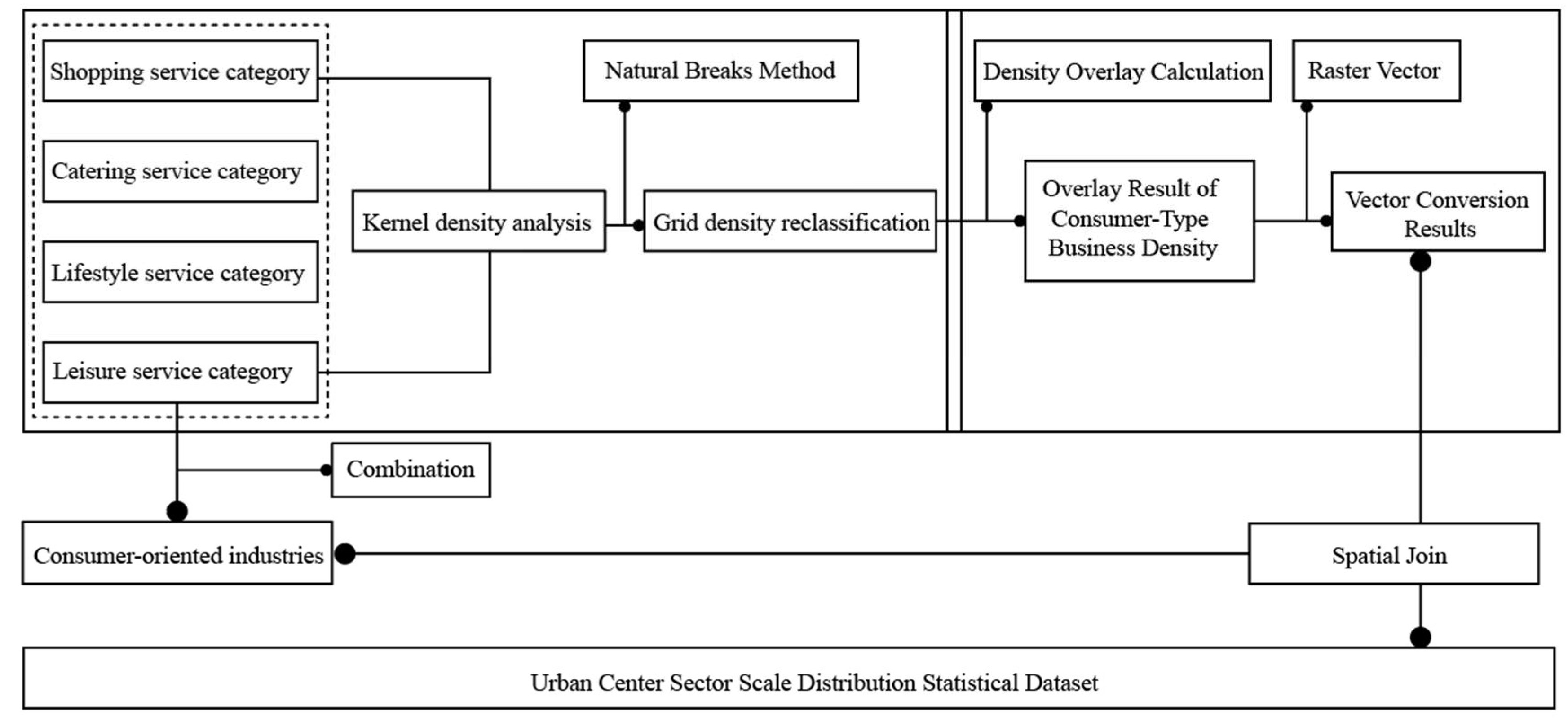

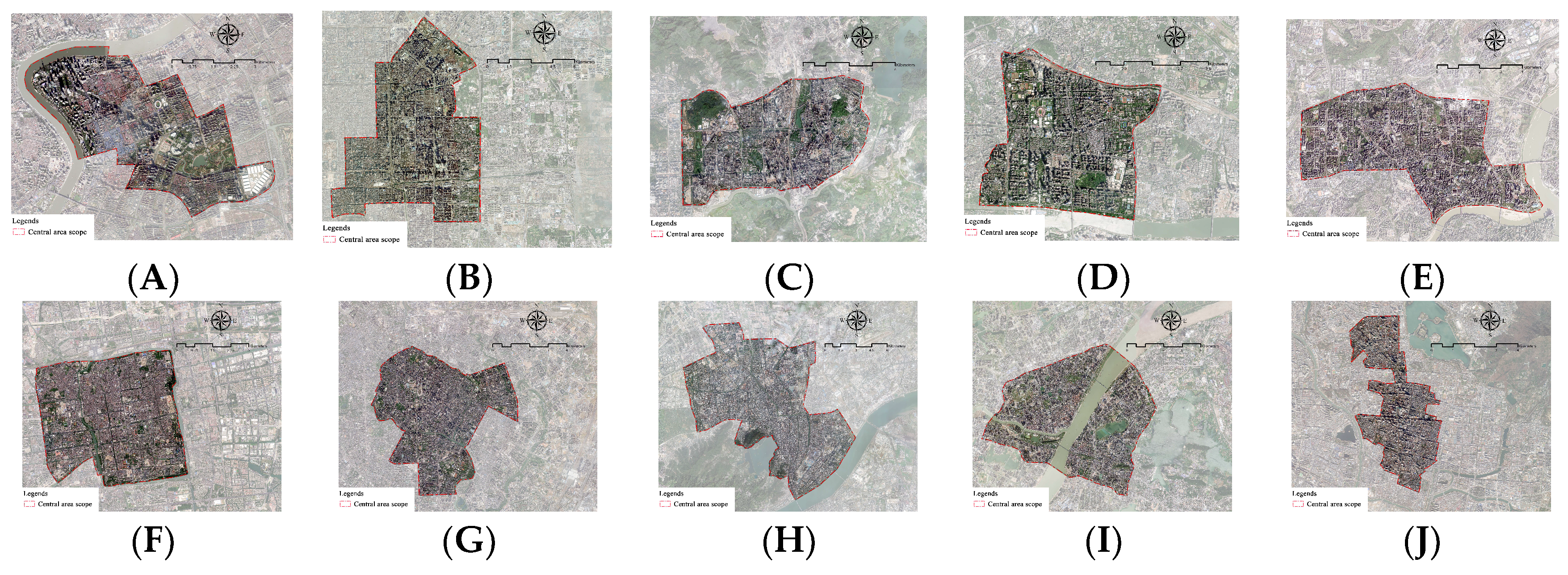
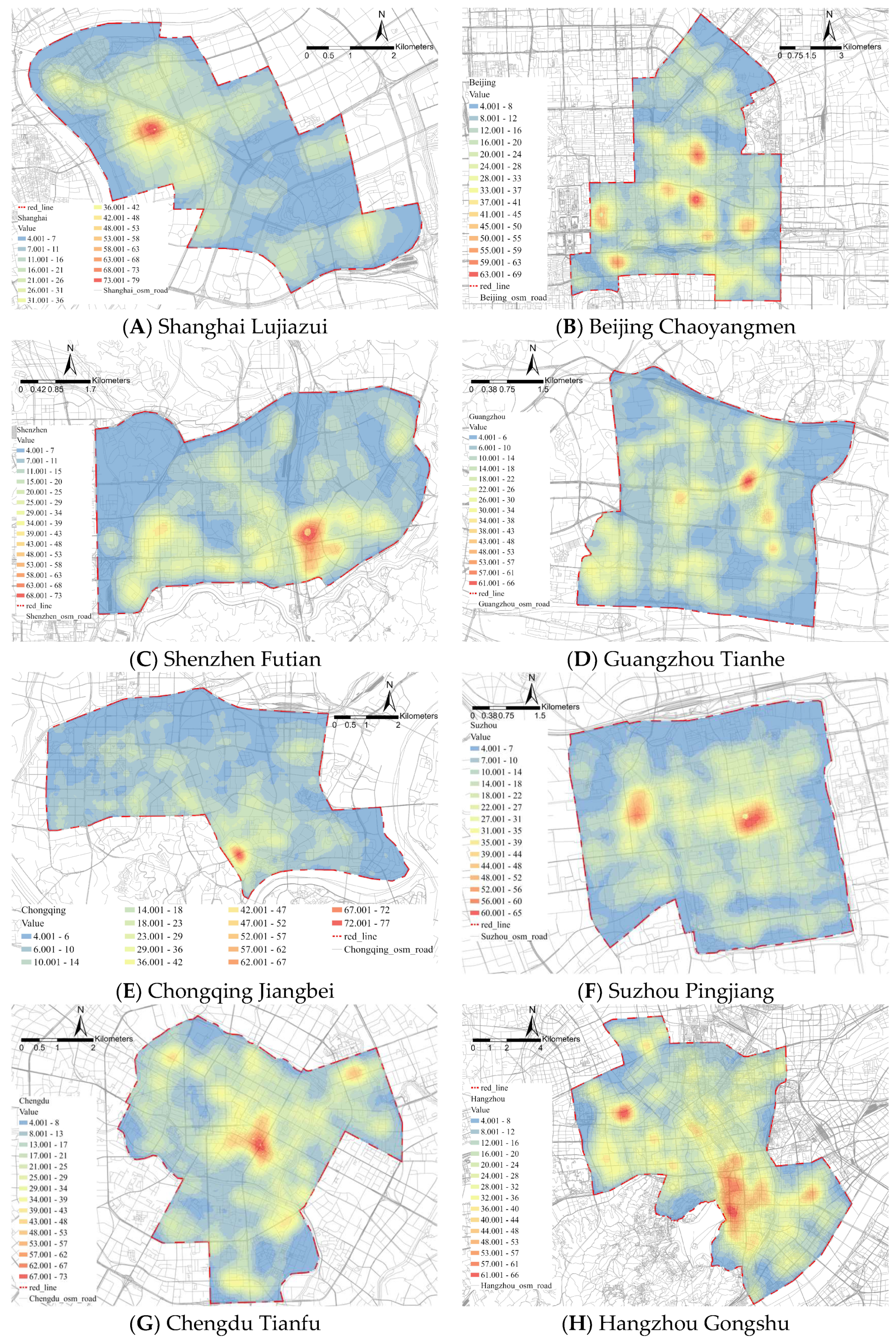
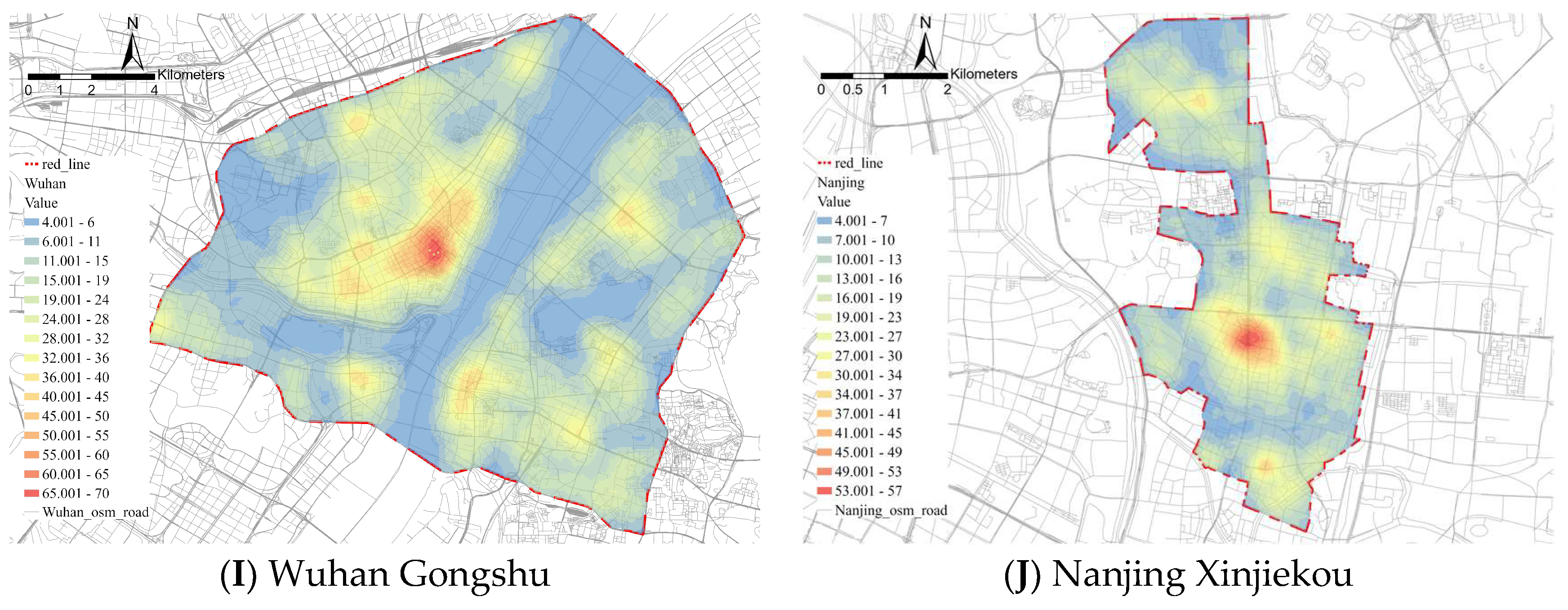
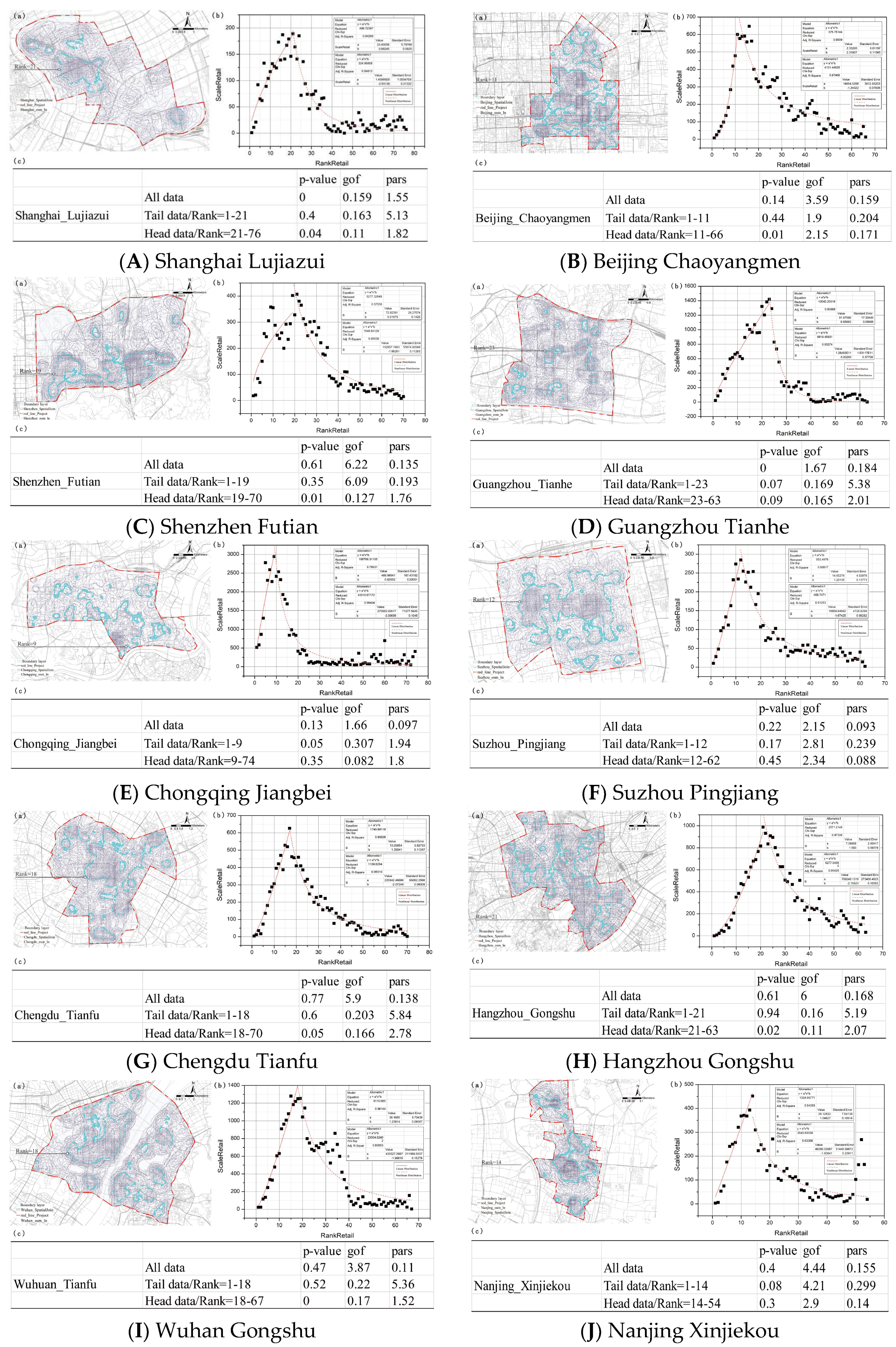
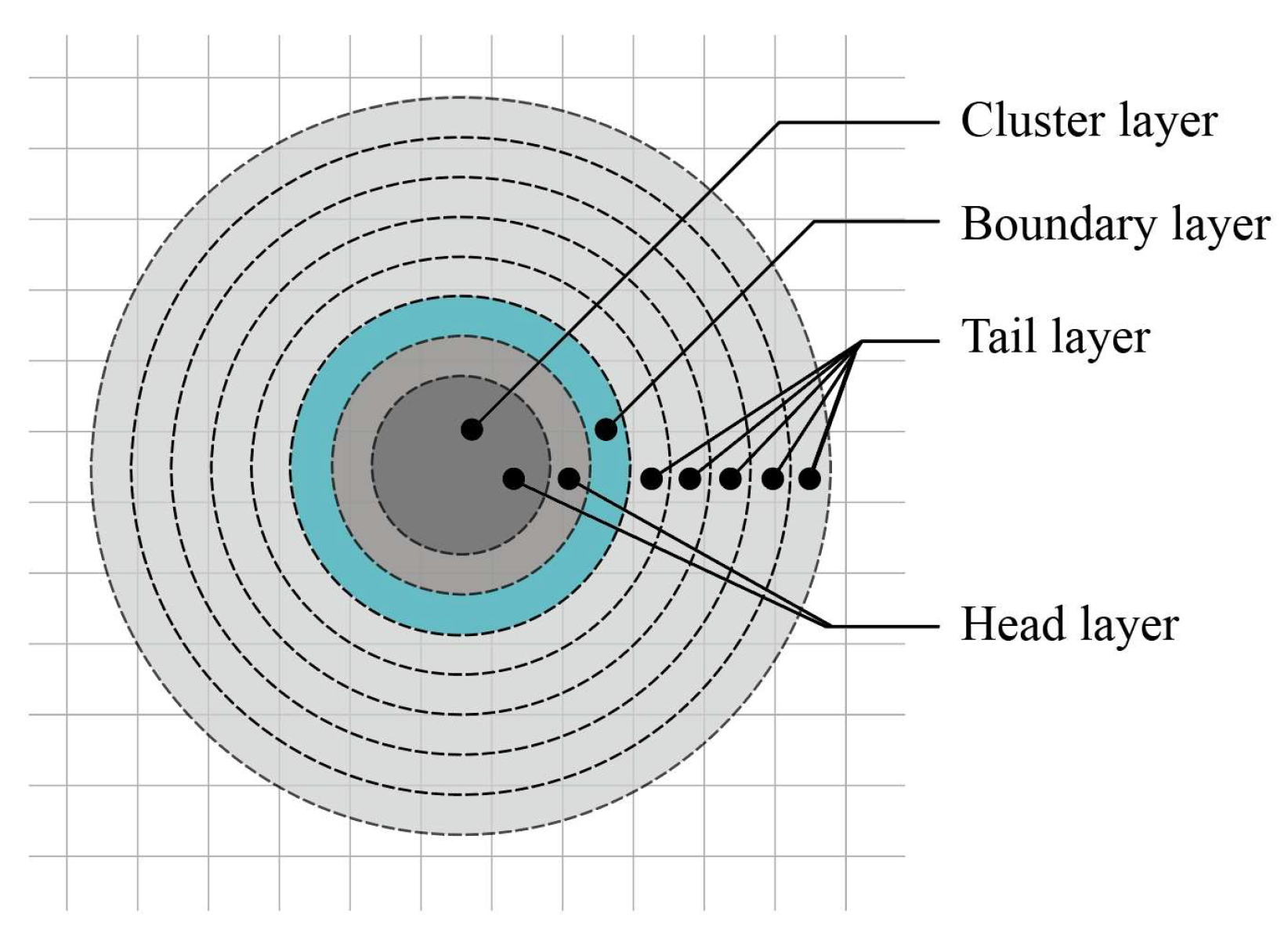
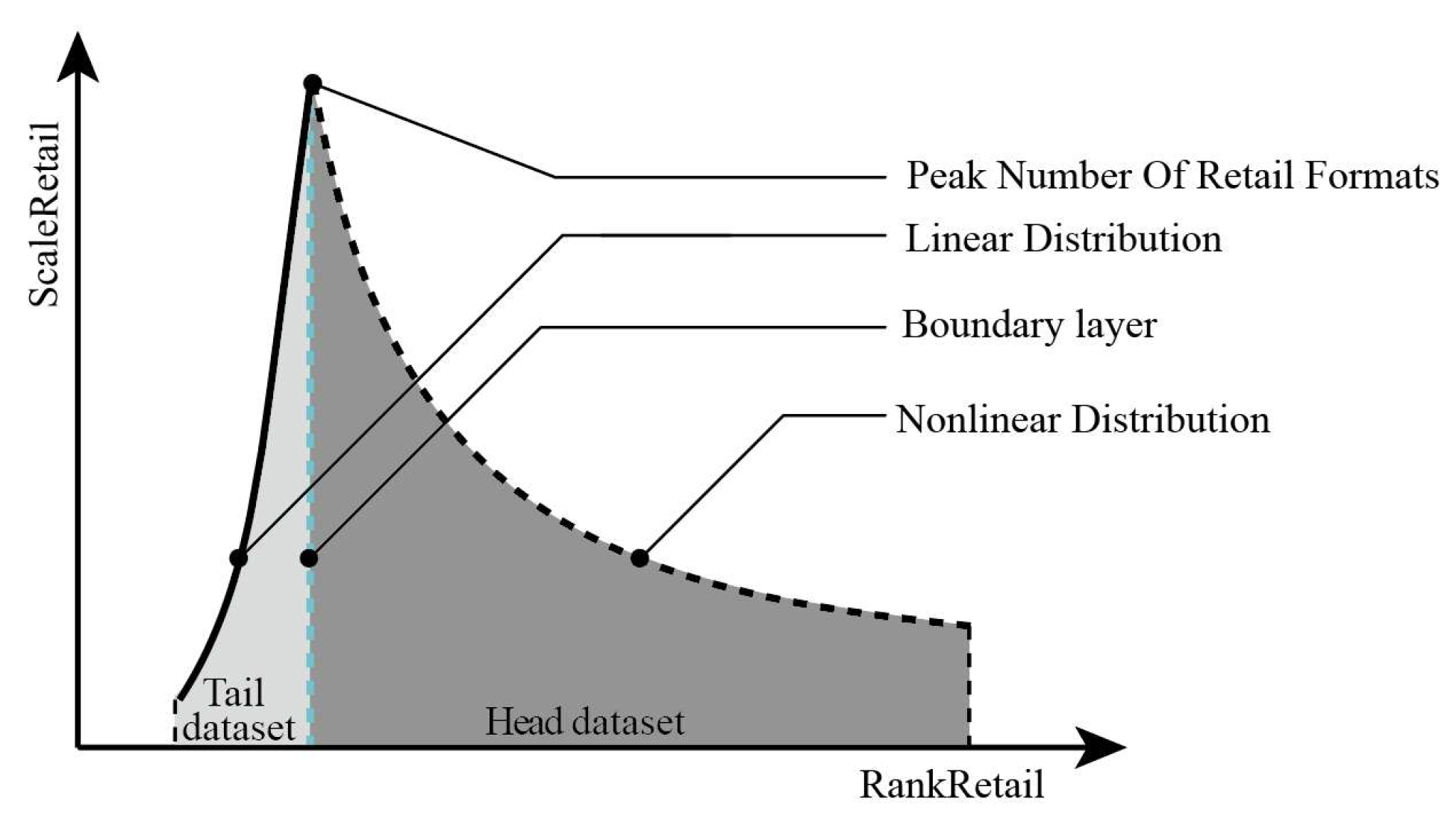

| Serial Number | City | Gross Domestic Product (Billion Yuan) |
|---|---|---|
| 1 | Shanghai | 38,701 |
| 2 | Beijing | 36,103 |
| 3 | Shenzhen | 28,000 |
| 4 | Guangzhou | 25,019 |
| 5 | Chongqing | 25,003 |
| 6 | Suzhou | 20,171 |
| 7 | Chengdu | 17,717 |
| 8 | Wuhan | 16,106 |
| 9 | Hangzhou | 15,623 |
| 10 | Nanjing | 14,718 |
| Business Categories | Classification of Service Industry Sectors | POI Types |
|---|---|---|
| Shopping Services | Commercial Centres, Shopping Malls, etc. | Convenience Stores, Clothing Stores, etc. |
| Catering Services | Catering Industry | Snack Shops, Restaurants, etc. |
| Lifestyle Services | Residential Services, Daily Product Repair, etc. | Auto Repair Shops, Hardware Stores, Hair Salons, etc. |
| Leisure Services | Entertainment Industry, Sports and Fitness | Cinemas, KTV (Karaoke), Gyms, etc. |
| City | Power Law Distribution Verification | ||
|---|---|---|---|
| Overall Dataset | Tail Dataset | Head Dataset | |
| Shanghai Lujiazui | × | O | × |
| Beijing Chaoyangmen | × | O | × |
| Shenzhen Futian | O | O | × |
| Guangzhou Tianhe | × | × | × |
| Chongqing Jiangbei | × | × | O |
| Suzhou Pingjiang | × | × | O |
| Chengdu Tianfu | O | O | × |
| Wuhan Gongshu | O | × | × |
| Hangzhou Gongshu | O | O | × |
| Nanjing Xinjiekou | O | × | O |
Disclaimer/Publisher’s Note: The statements, opinions and data contained in all publications are solely those of the individual author(s) and contributor(s) and not of MDPI and/or the editor(s). MDPI and/or the editor(s) disclaim responsibility for any injury to people or property resulting from any ideas, methods, instructions or products referred to in the content. |
© 2024 by the authors. Licensee MDPI, Basel, Switzerland. This article is an open access article distributed under the terms and conditions of the Creative Commons Attribution (CC BY) license (https://creativecommons.org/licenses/by/4.0/).
Share and Cite
Shi, Y.; Wang, Y.; Ren, Y.; Zhou, C.; Hu, X. Scale Distribution of Retail Formats in the Central Districts of Chinese Cities: A Study Analysis of Ten Cities. ISPRS Int. J. Geo-Inf. 2024, 13, 136. https://doi.org/10.3390/ijgi13040136
Shi Y, Wang Y, Ren Y, Zhou C, Hu X. Scale Distribution of Retail Formats in the Central Districts of Chinese Cities: A Study Analysis of Ten Cities. ISPRS International Journal of Geo-Information. 2024; 13(4):136. https://doi.org/10.3390/ijgi13040136
Chicago/Turabian StyleShi, Yi, Yidian Wang, Yifan Ren, Chunyu Zhou, and Xinyu Hu. 2024. "Scale Distribution of Retail Formats in the Central Districts of Chinese Cities: A Study Analysis of Ten Cities" ISPRS International Journal of Geo-Information 13, no. 4: 136. https://doi.org/10.3390/ijgi13040136
APA StyleShi, Y., Wang, Y., Ren, Y., Zhou, C., & Hu, X. (2024). Scale Distribution of Retail Formats in the Central Districts of Chinese Cities: A Study Analysis of Ten Cities. ISPRS International Journal of Geo-Information, 13(4), 136. https://doi.org/10.3390/ijgi13040136






